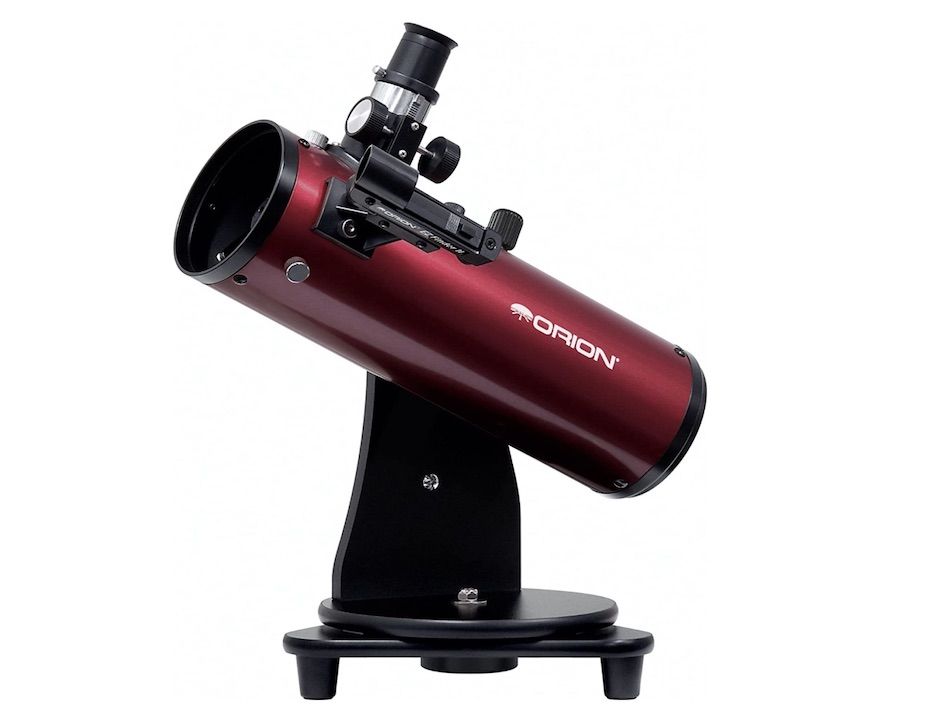
However, when I ordered the tube rings something like the 22nd of December for an expected delivery date of mid-January, they didn't arrive until the 16th of February. I've been very lucky with pandemic telescope availability, and most of the equipment I've ordered has arrived ahead of schedule. I didn't order a dovetail bar, to save money, since the telescope already has one. The 116mm tube rings I ordered, based on measurements of the tube's outer diameter, turned out to be slightly too large. Instead, I decided to order some tube rings from Orion. With Quinn's permission, I was going to keep the SkyScanner for a few days and drill out the new holes to remount the dovetail, but I chickened out since I have no experience with drilling holes in metal and it wasn't my telescope to ruin. He doesn't like red dot finders (I like them fine, when used properly) and removed his, but the replacement laser wasn't an option in this case. In an article by Matt Wedel on his blog, 10 Minute Astronomy, he details 6 hacks to the Orion SkyScanner including remounting the dovetail bracket to a different angle, thereby putting the eyepiece at a more comfortable angle. Quinn has worse mobility than I, and simply can't get her head behind the finder in most cases. I can barely do it, and don't have great mobility myself.

The red dot finder meanwhile is on the side, meaning you have to bend down very low to get your eye behind it.

The SkyScanner's eyepiece is on the top of the OTA (when pointed near the horizon), and thus you have to lean down over it to look through. This use case requires being very comfortable to use and having an adequate unit-power finder, since a right angle finderscope would be overkill. As the name implies it's to be used for scanning the skies for deep sky objects, a bit like a pair of binoculars, except with a sturdy mount instead of a finicky tripod or wobbly hands. The Orion SkyScanner 100 is a 4" f/4 Newtonian reflector with a non-diffraction-limited parabolic mirror, on a tabletop Dobsonian mount which is simple, sturdy, and easy to use. So I had to work to fix the eyepiece and finderscope problem.
#ORION SKYSCANNER 100 REFLECTOR HOW TO#
While teaching Quinn, how to use the telescope, we found that due to some motor disabilities she deals with, the telescope was ergonomically almost unusable. The eyepiece ends up too high and the straight-thru finder too low. As noted in my review and pretty much any time I talk about it, the position of the red dot finder and the eyepiece is. The pic below shows the center-spot ring on the primary and the three tilt screws (holes) for adjusting the secondary mirror.For Christmas, I bought my cousin Quinn (19) an Orion SkyScanner 100, one of the telescopes I recommend most for beginners on a budget, especially but not limited to kids. There are still hundreds more DSO's awaiting my discovery with this scope. and it's still my most widely used scope, despite already owning 5 larger ones! It's easy to transport to darker sky sites and has just enough aperture to see a wealth of deep-sky objects. I've used the Orion SkyScanner for over 2.5 yrs. I check the collimation each time before use - it holds collimation pretty well.

Stars look more like pinpoints of light, with double stars more cleanly resolved and out-of-focus bright stars showing perfectly concentric rings. The moon and planets are more sharply focused. Once I followed these 3 steps, the views through my scope improved enormously. The primary mirror end fits snug-tight at the end of the tube, so it's more likely the secondary to be misaligned during shipment from factory to warehouse to buyer.Īnyways, here's what I strongly recommend doing:ġ) Remove the mirror end of the scope and center spot the primary mirror with black pen/marker and notebook reinforcement ring (I used Gary Seronik's method for center-spotting a primary mirror).Ģ) Get a collimation cap (I used the one that comes with Orion's Newtonian scopes from Starblast 4.5 and up) and insert into the focuserģ) While looking through the cap and focuser, use an Allen-head screwdriver to adjust the 3 tilt screws on the secondary mirror holder until the black dot is center spotted within the ring of the primary. Just saw this thread, sorry for the late reply. Is there some rig I can make that would allow me to adjust the whole cell. I need to know how to adjust the primary mirror too. You can adjust the secondary, but you need to collimate the primary too. Its all just one cell that has the mirror glued in it. I have a SkyScanner 100 Reflector which is 4" and its a nice little scope but when Orion makes these scopes, they unfortunately glue the primary mirror to the cell, but there are no collimation bolts on the back.


 0 kommentar(er)
0 kommentar(er)
